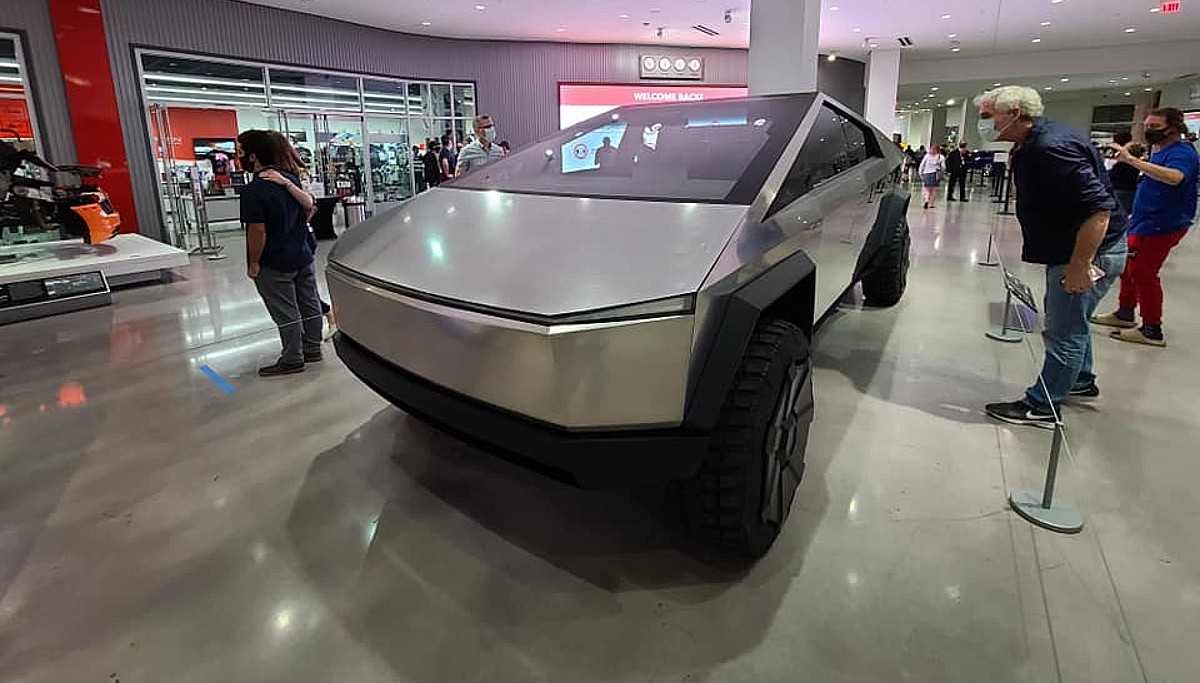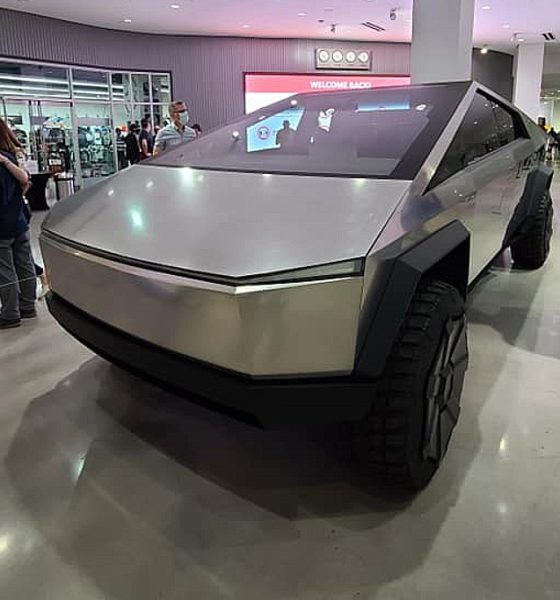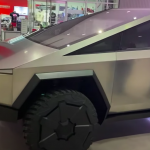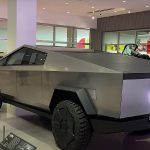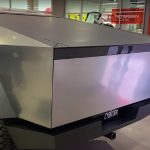Tesla Cybertruck took center stage at the Petersen Automotive Museum on Saturday, dazzling fans in its first of six days as a display piece at the legendary gallery in Los Angeles.
Today’s debut at the Petersen Museum follows this week’s reveal that the Cybertruck would be arriving at the gallery after the museum added the all-electric pickup to its website.
The Petersen Auto Museum was opened in 1994 and is one of the most extensive museums for cars and motorcycles in the world. The Cybertruck’s appearance at the Museum shows worldwide recognition for Tesla’s newest pickup, and it joins the Model S prototype as the company’s only vehicles in the massive gallery.
Peterson welcomed the Cybertruck inside the museum last night. Video from @Chad_Hodge surfaced, showing the massive truck being unloaded from a hauler, which was then transported into the facility and set up as an exhibit.
JUST NOW umm isn’t this the Tesla Cybertruck?! Arriving in LA to the car museum 🤩 #Tesla #CyberTruck pic.twitter.com/Hh3sfyGvnV
— Chad Hodge (@chad_hodge) June 20, 2020
Now, the truck is inside, and those who bought tickets for admission into the museum are getting the opportunity to stand just a few feet from the unique design from Tesla’s engineers. Many of those who came to the museum to see the Cybertruck are showing photos and videos of the machine, which sits stationary surrounded by ropes, dawning a license plate that says, “CYBRTRK.”
- Credit: gaussdog on YouTube
- Credit: gaussdog on YouTube
- Credit: gaussdog on YouTube
- Credit: gaussdog on YouTube
Closeups of the Cybertruck reveal the tugged and robust exterior of the all-electric pickup. The 30X series stainless steel exterior is dent-proof while the glass that is used for all of the windows will be bulletproof.
It was recently announced that the truck would only be available in its stainless steel color, but it can be wrapped in any color or pattern, Musk said. This means the appearances and looks of the Cybertruck will be endless, combining personality and creativity to each of the builds that the owner will design themselves.
The Cybertruck has been seen around Los Angeles by a few lucky spectators, but it has mainly been a rare sight for the public. Its appearance at the Petersen Museum is the first time the truck has been on display for the public to view at their leisure. Tesla’s Cybertruck unveiling event was on an invite-only basis, allowing a select few lucky viewers to watch CEO Elon Musk and Chief Designer Franz von Holzhausen explain the finer points of the pickup’s design.
The widely popular design of the Cybertruck was met with both support and criticism after its unveiling event. However, there is no denying that the pickup’s futuristic design has enticed many people to consider the vehicle as a catalyst for a new era in the automotive sector.
The truck’s Dual and Tri-Motor configurations will be built at the company’s next production facility in the United States in 2021. The new facility will be built in a location yet to be determined.
H/t: @TeslaNY on Twitter

Elon Musk
Elon Musk and Tesla AI Director share insights after empty driver seat Robotaxi rides
The executives’ unoccupied tests hint at the rapid progress of Tesla’s unsupervised Robotaxi efforts.

Tesla CEO Elon Musk and AI Director Ashok Elluswamy celebrated Christmas Eve by sharing personal experiences with Robotaxi vehicles that had no safety monitor or occupant in the driver’s seat. Musk described the system’s “perfect driving” around Austin, while Elluswamy posted video from the back seat, calling it “an amazing experience.”
The executives’ unoccupied tests hint at the rapid progress of Tesla’s unsupervised Robotaxi efforts.
Elon and Ashok’s firsthand Robotaxi insights
Prior to Musk and the Tesla AI Director’s posts, sightings of unmanned Teslas navigating public roads were widely shared on social media. One such vehicle was spotted in Austin, Texas, which Elon Musk acknowleged by stating that “Testing is underway with no occupants in the car.”
Based on his Christmas Eve post, Musk seemed to have tested an unmanned Tesla himself. “A Tesla with no safety monitor in the car and me sitting in the passenger seat took me all around Austin on Sunday with perfect driving,” Musk wrote in his post.
Elluswamy responded with a 2-minute video showing himself in the rear of an unmanned Tesla. The video featured the vehicle’s empty front seats, as well as its smooth handling through real-world traffic. He captioned his video with the words, “It’s an amazing experience!”
Towards Unsupervised operations
During an xAI Hackathon earlier this month, Elon Musk mentioned that Tesla owed be removing Safety Monitors from its Robotaxis in Austin in just three weeks. “Unsupervised is pretty much solved at this point. So there will be Tesla Robotaxis operating in Austin with no one in them. Not even anyone in the passenger seat in about three weeks,” he said. Musk echoed similar estimates at the 2025 Annual Shareholder Meeting and the Q3 2025 earnings call.
Considering the insights that were posted Musk and Elluswamy, it does appear that Tesla is working hard towards operating its Robotaxis with no safety monitors. This is quite impressive considering that the service was launched just earlier this year.
Elon Musk
Starlink passes 9 million active customers just weeks after hitting 8 million
The milestone highlights the accelerating growth of Starlink, which has now been adding over 20,000 new users per day.

SpaceX’s Starlink satellite internet service has continued its rapid global expansion, surpassing 9 million active customers just weeks after crossing the 8 million mark.
The milestone highlights the accelerating growth of Starlink, which has now been adding over 20,000 new users per day.
9 million customers
In a post on X, SpaceX stated that Starlink now serves over 9 million active users across 155 countries, territories, and markets. The company reached 8 million customers in early November, meaning it added roughly 1 million subscribers in under seven weeks, or about 21,275 new users on average per day.
“Starlink is connecting more than 9M active customers with high-speed internet across 155 countries, territories, and many other markets,” Starlink wrote in a post on its official X account. SpaceX President Gwynne Shotwell also celebrated the milestone on X. “A huge thank you to all of our customers and congrats to the Starlink team for such an incredible product,” she wrote.
That growth rate reflects both rising demand for broadband in underserved regions and Starlink’s expanding satellite constellation, which now includes more than 9,000 low-Earth-orbit satellites designed to deliver high-speed, low-latency internet worldwide.
Starlink’s momentum
Starlink’s momentum has been building up. SpaceX reported 4.6 million Starlink customers in December 2024, followed by 7 million by August 2025, and 8 million customers in November. Independent data also suggests Starlink usage is rising sharply, with Cloudflare reporting that global web traffic from Starlink users more than doubled in 2025, as noted in an Insider report.
Starlink’s momentum is increasingly tied to SpaceX’s broader financial outlook. Elon Musk has said the satellite network is “by far” the company’s largest revenue driver, and reports suggest SpaceX may be positioning itself for an initial public offering as soon as next year, with valuations estimated as high as $1.5 trillion. Musk has also suggested in the past that Starlink could have its own IPO in the future.
News
NVIDIA Director of Robotics: Tesla FSD v14 is the first AI to pass the “Physical Turing Test”
After testing FSD v14, Fan stated that his experience with FSD felt magical at first, but it soon started to feel like a routine.

NVIDIA Director of Robotics Jim Fan has praised Tesla’s Full Self-Driving (Supervised) v14 as the first AI to pass what he described as a “Physical Turing Test.”
After testing FSD v14, Fan stated that his experience with FSD felt magical at first, but it soon started to feel like a routine. And just like smartphones today, removing it now would “actively hurt.”
Jim Fan’s hands-on FSD v14 impressions
Fan, a leading researcher in embodied AI who is currently solving Physical AI at NVIDIA and spearheading the company’s Project GR00T initiative, noted that he actually was late to the Tesla game. He was, however, one of the first to try out FSD v14.
“I was very late to own a Tesla but among the earliest to try out FSD v14. It’s perhaps the first time I experience an AI that passes the Physical Turing Test: after a long day at work, you press a button, lay back, and couldn’t tell if a neural net or a human drove you home,” Fan wrote in a post on X.
Fan added: “Despite knowing exactly how robot learning works, I still find it magical watching the steering wheel turn by itself. First it feels surreal, next it becomes routine. Then, like the smartphone, taking it away actively hurts. This is how humanity gets rewired and glued to god-like technologies.”
The Physical Turing Test
The original Turing Test was conceived by Alan Turing in 1950, and it was aimed at determining if a machine could exhibit behavior that is equivalent to or indistinguishable from a human. By focusing on text-based conversations, the original Turing Test set a high bar for natural language processing and machine learning.
This test has been passed by today’s large language models. However, the capability to converse in a humanlike manner is a completely different challenge from performing real-world problem-solving or physical interactions. Thus, Fan introduced the Physical Turing Test, which challenges AI systems to demonstrate intelligence through physical actions.
Based on Fan’s comments, Tesla has demonstrated these intelligent physical actions with FSD v14. Elon Musk agreed with the NVIDIA executive, stating in a post on X that with FSD v14, “you can sense the sentience maturing.” Musk also praised Tesla AI, calling it the best “real-world AI” today.
